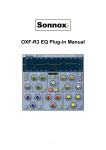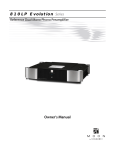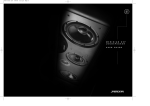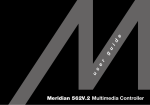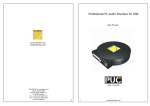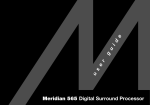Download Meridian DSP33 User guide
Transcript
e i d u g r e s u Meridian DSP33 Digital Loudspeaker System Meridian DSP33 Digital Loudspeaker System User Guide Preface i Sales and service in the UK Meridian Audio Ltd Stonehill Stukeley Meadows Sales and service in the USA Cambs PE18 6ED Meridian America Inc England 3800 Camp Creek Parkway Building 2400 Tel␣ ␣ (01480) 52144 Fax␣ ␣ (01480) 459934 Suite 122 Atlanta Digital Gramophone and Wireless Ltd GA 30331 Stonehill World Wide Web http://www.meridian-audio.com Designed and manufactured in the UK by Stukeley Meadows Tel␣ ␣ (404) 344 7111 Cambs Fax␣ ␣ (404) 346 7111 PE18 6ED Part no: DSP33 England Copyright © 1999 Digital Gramophone and MHR: This product incorporates copyright Reverse engineering or circumvention of Wireless Ltd. protection technology covered by certain this protection is strictly prohibited. Preface patent applications and intellectual ii Boothroyd|Stuart Meridian, Meridian, property of Meridian Audio Ltd. This This guide was produced by Meridian Digital Theatre, Meridian technology is provided for the express Human-Computer Interface Ltd, Lossless Packing, MHR, and MLP are purpose of securely containing copyright http://www.interface.co.uk registered trademarks of Meridian audio within the Meridian System only. Audio Ltd. Contents Introduction 1 Introduces the DSP33 Digital Loudspeaker System, and gives guidelines and suggested layouts to help you plan your Setting up the DSP33 Digital Loudspeaker System 9 surround system. Describes how to unpack and install the The DSP33 Digital Loudspeaker digital loudspeakers and explains how to System ................................................... 2 connect them to your equipment. Using the DSP Digital Loudspeaker System 19 Unpacking .............................................. 10 Provides step-by-step instructions for Positioning the digital loudspeakers ...... 11 operating the digital loudspeakers in Connecting the loudspeakers ................ 13 compact systems with no other Connecting the digital loudspeakers ..... 15 preamplifier or control unit. Sample configurations ........................... 5 Specification and accessories ............... 7 Selecting a source ................................. 20 Adjusting the volume ............................. 21 Adjusting the balance or phase ............. 22 Preface iii Configuring the DSP33 loudspeakers using a computer 23 Describes how to configure the digital loudspeakers using the Meridian Configuration program. Troubleshooting 35 The Meridian Configuration program ..... 24 Provides suggested solutions to typical Running the Meridian Configuration problems. program ................................................. 25 Creating a new settings file .................... 27 Troubleshooting ..................................... 36 Changing the setup options ................... 29 Service and guarantee ........................... 39 Setting up sources ................................. 31 Preface Completing the configuration ................ 34 iv Index ...................................................... 41 Introduction The Meridian DSP33 Digital Loudspeaker System combines the latest acoustic and drive unit technology with multiple built-in power amplifiers and advanced high precision digital signal processing. The result is a speaker that produces extremely high-quality sound from a compact enclosure, and is ideal either as part of a stereo system or a full home theatre. For instructions on setting up the loudspeakers turn to the next chapter, Setting up the DSP33 Digital Loudspeaker System. Once they have been set up refer to Using DSP33 Digital Loudspeaker System, page 19, for information about getting the best results from all your music and film recordings. Introduction 1 The DSP33 Digital Loudspeaker System The DSP33 Digital Loudspeaker System incorporates the result of several years of research and development into innovative technologies. ❍ To perform filtering or adjustment of the frequency response; eg treble or bass. ❍ To provide volume control to 48-bit precision. ❍ To provide bass extension by boosting the bass at moderate Digital Signal Processing levels to take full advantage of the capabilities of the drive units. Digital Signal Processing, or DSP, is a technique pioneered by Meridian in hi-fi products for achieving extremely accurate If you are using the DSP33 Digital Loudspeaker System with a reproduction of audio signals using high-precision mathematical digital source, such as CD or DVD, the signals remain in digital processing. form until the last possible stage. DSP allows sophisticated processing to be performed without DSP33 drivers any of the cumulative noise or degradation that inevitably occurs, even with high-quality analogue circuitry. In addition, the Each DSP33 loudspeaker uses two parallel 125mm (5") bass signal improvement techniques incorporated in the DSP33 drive units. These incorporate a cast alloy chassis and a carbon would be virtually impossible to implement in analogue circuitry. fibre cone, and have a very large magnet which provides Introduction excellent drive and control. Combined with the Meridian’s active 2 The DSP33 takes advantage of DSP for several different bass extension technology, they provide surprisingly rich, deep functions: bass, quite unprecedented for this size of cabinet. ❍ To remove timing variations from the incoming digital signals The treble unit is a very high quality 25mm (1") aluminium dome (de-jittering). ❍ To split the frequency band between the treble and bass drivers (crossover). with a Neodymium magnet and a protective grille. It is extremely well matched to the woofer, and also tonally very compatible with the other speakers in the Meridian range. Power amplifiers Mounting options The speakers are driven by two high-power low-feedback power The DSP33 is designed to be used either vertically or amplifiers. The combination of idealised magnetic design, horizontally mounted and uses fully shielded drive units so that it careful star earthing, and very fast output devices give the can be placed above or below a television without interference. amplifiers extremely low noise, high detail, and fast bass. If ordered as a centre it is supplied with a plinth, which can be used to give rigid support and tilt the centre channel towards the The whole electronic assembly is supplied from a substantial listener. torroidal transformer feeding high-quality audiophile-grade capacitors. Meridian High Resolution (MHR) Cabinet The DSP33 Digital Loudspeaker System supports Meridian High Resolution (MHR), to allow you to connect to other MHR- Each DSP33 loudspeaker is built around a precision compliant Meridian products to take advantage of high-rate manufactured aluminium cabinet. The rigidity of this material, audio sources, and provide the additional benefits of lower jitter combined with the built-in structural elements, gives incredibly and improved sound quality on all sources. low levels of cabinet resonance, which is further reduced by MHR is a proprietary secure encoding format that uses colouration, giving the loudspeaker amazing mid-range encryption and anti-copy methods to provide a secure copyright transparency. protection environment, and allow the secure transfer of audio streams within a Meridian-only system for playback only. Introduction additional damping. This results in a cabinet of exceptionally low 3 Meridian Comms The DSP33 Digital Loudspeaker System is part of the Meridian family of advanced digital, analogue, and video components, and these incorporate a sophisticated communications link, to allow you to control any combination of units using a single remote, and ensure that they will work together as a fully integrated system. The communications system also allows you to extend your hi-fi system into two or three rooms, with the ability to control the sources in one room from the controller in another room. The following pages show two recommended configurations based on the DSP33 Digital Loudspeaker System to illustrate Introduction the flexibility of Meridian components. 4 Sample configurations Meridian Digital Compact Theatre™ DSP33 rear DSP33 rear DSP33 DSP33 Meridian DVD Player DSP33 D1500 Meridian Surround Processor The DSP33 provides an unusually good response for such a Meridian Surround Processor to create a compact surround compact case, and can be mounted either horizontally or system with superb music and cinema sound. vertically for total flexibility. A Meridian D1500 Digital Subwoofer can be added for extended bass performance. Introduction Five DSP33 loudspeakers can be used in conjunction with a 5 DSP33 Digital Loudspeaker System Other applications Other applications include: DSP33 DSP33 ❍ High-quality multimedia PC speakers with RS232 control of volume etc. ❍ Surround speaker in a Meridian Digital Theatre (extra S5 lead required). ❍ Main speaker in a Digital Music System with a Meridian CD Player (512 and D5 lead required). Meridian DVD Player 512 ❍ Main speakers with another source of digital audio; eg satellite (512, D5 lead and MSR required). ❍ Second zone speaker in a Meridian two-room plus system (long M5 lead, 512, D5 lead, and MSR required). The DSP33 can be connected directly to almost any source that provides a PCM SPDIF output, including CD or DVD players, some PC soundcards, and digital satellite decoders. The DSP33 includes a DSP volume control, and with Meridian sources this Introduction operates seamlessly via the 500 comms system. 6 Alternatively, the volume can be controlled with the Meridian System Remote using the optional 512 Remote Eye, or via the RS232 interface using the optional RS232 lead. These applications may require additional accessories; for more information see Available accessories, page 8. Specification and accessories Specification Frequency response In room response within 3dB, 60Hz20kHz, lower at moderate volumes. Digital inputs 2 x cable, 75Ω, IEC958, 32-96kHz. FIFO locks at 44.1, 48, 88.2, or 96kHz ± Crossover Linear-phase ±30º at 2.3kHz. 150ppm. Drive units Woofers: 2 x 125mm (5") carbon fibre custom drivers, cast alloy chassis. 1 x digital output cable, 75Ω, IEC958, providing a copy of the selected input. Processing 1 x Motorola 56364 running at 100MHz. Power amplifiers Low feedback complementary bipolar Tweeter: 1 x 25mm (1") aluminium dome neodymium magnet, with protective grille. Control design, with output-stage error 9-pin D connector for RS232 PC setup correction and twin loop design. and control, null modem, 9600 baud, 2N1, no handshake. Treble: 50W RMS. Bass: 85W RMS. Digital to analogue 24-bit Delta-Sigma. conversion Cabinet Extruded and cast aluminium with bracing elements. Dimensions 150mm x 395mm x 210mm (5.9" x 15.6" x 8.3") (W x H x D). Typically <0.01%, or <0.05% up to full power at all frequencies. Noise and hum <-95dBr at all volume settings. Acoustic output Typically >104dB spl @ 1m. Acoustic noise <15dB spl @ 1m. Weight 9.5kg (21lb) each. Power 100-125; 200-250V AC 50-60Hz. 6VA idle; 200VA max. Introduction Distortion 2 x Meridian Comms. Meridian Audio reserves the right to amend product specifications at any time. 7 Available accessories The DSP33 is shipped ready to be used as the front speakers in a small Meridian Digital Theatre with a Meridian DVD Player (such as the 800 or 580) or a Meridian Digital Surround Controller (such as the 861, 568, or 561). Other applications, and some advanced features, may require one or more of the following accessories, which can be purchased from your Meridian dealer. ❍ Meridian System Remote. ❍ 512 Remote Eye for remote control reception. ❍ D5 lead for connecting between the 512 and DSP33. ❍ Additional S5 leads (8m and 14m). ❍ 511 S-patch box if connecting more than two DSP33s to a 561 Digital Surround Controller or 568 Digital Surround Introduction Processor. 8 This chapter explains how to install the DSP33 Digital Loudspeaker System. It describes what you should find when you unpack the speakers, how you should connect them to your other audio equipment, and the siting constraints. Before you begin installation you should ensure that your digital loudspeaker system is the correct voltage for your local AC supply. If it is not, do not try to install the unit, and contact your dealer. You should not make any connections to the digital loudspeakers, or to any other component in your system, while the AC power supply is connected and switched on. Setting up the DSP33 Digital Loudspeaker System Setting up the DSP33 Digital Loudspeaker System 9 Unpacking The digital loudspeaker system is supplied in a box containing Radio interference the following components: Setting up the DSP33 Digital Loudspeaker System FCC Warning: This equipment generates and can radiate radio 10 ❍ DSP33 Loudspeaker(s) complete with grille. frequency energy and if not installed and used correctly in ❍ Four self-adhesive feet per speaker. accordance with our instructions may cause interference to ❍ This user guide. radio communications or radio and television reception. It has ❍ Power cord suitable for your territory per speaker. been type-tested and complies with the limits set out in Subpart ❍ Meridian M5 lead. J, Part 15 of FCC rules for a Class B computing device. These ❍ Meridian S5 lead. limits are intended to provide reasonable protection against ❍ Meridian Configuration program. such interference in home installations. ❍ RS232 cable. ❍ R reset plug (see page 13). EEC: This product has been designed and type-tested to ❍ Centre channel plinth (if ordered as a centre channel). comply with the limits set out in EN55013 and EN55020. If any of these items is missing, please contact your dealer. We suggest that you retain the packaging carefully, as it provides maximum protection in transit. Positioning the digital loudspeakers Safety warnings To position the digital loudspeakers ❍ Do not expose the speakers to dripping or splashing. The DSP33 loudspeakers can be used either horizontally or ❍ Do not place any object filled with liquid, such as a vase, on vertically. If the DSP33 is mounted on a bookshelf, or mounted on the speakers. horizontally on top of a television, the feet should be attached as shown below. The best sound will only be obtained if the DSP33 is firmly mounted, and does not rock when pushed. To avoid overheating Do not position the speakers: ❍ In direct sunlight. ❍ Near heat sources, such as a radiator. ❍ Directly on top of heat producing equipment, such as a power amplifier. The DSP33 cabinet acts as a heatsink and requires adequate ventilation. Ensure that air can flow around it. To avoid interference Do not position the speakers: ❍ Near strong magnetic radiation, such as near a power amplifier. Vertical Horizontal Setting up the DSP33 Digital Loudspeaker System the speakers. ❍ Do not place naked flame sources, such as lighted candles, 11 To obtain the best sound To wall mount the digital loudspeakers For best results adjust the position of the loudspeakers while Setting up the DSP33 Digital Loudspeaker System listening to music. 12 The DSP33 has been designed to be secured with an OmniMount 75 Series wall bracket, details of which may be If possible, have the most acoustically absorbent wall in the obtained from OmniMount Systems, USA (818-766-9000). The room behind the front speakers. Ideally have each DSP33 at mounting bolts are shown on the back panel. These are M6 least 0.5m (20") from a corner. Allen Bolts. Do not use any other bolt for the OmniMount bracket. Please follow the instructions for fitting provided with If the speakers are mounted on stands, position them the bracket. It is entirely the responsibility of the installer to approximately 0.25m (12") from the wall. ensure that the DSP33 is securely fastened. If you are using the speaker as a centre channel, place the No other bolts should be undone on the rear panel. speaker centrally between the main left-right pair and, if possible, arrange for the tweeters of the three speakers to be approximately the same height. The plinth allows the centre channel to tilt towards the listener for optimum imaging. Caution: The DSP33 is heavy for its size. Connecting the loudspeakers Back panel The following diagram gives details of the rear panel connections: DIGITAL INPUT OUTPUT MERIDIAN COMMS OUTPUT INPUT RS232 1 CHANNEL LEFT/ CENTRE Digital inputs Connections 2 RIGHT Comms Channel selection PC MERIDIAN COMMS OUTPUT INPUT RS232 1 2 CHANNEL Omnimount wall bracket fixing holes LEFT/ CENTRE RIGHT To reset the configuration of the digital loudspeaker OFF Power input ON Fuse The following procedure can be used to reset the configuration of the DSP33 loudspeaker to the default settings, without needing a computer, using the R reset plug supplied. ● Unplug the COMMS connections. ● Plug the R reset plug into the COMMS input socket. ● Switch the loudspeaker off, and then on again. Setting up the DSP33 Digital Loudspeaker System DIGITAL INPUT OUTPUT Digital output ● Replace the original COMMS connection. 13 Digital connections Communications connections The following table gives details of the digital audio inputs: The following table gives details of the communications Setting up the DSP33 Digital Loudspeaker System connections: 14 Use this input To connect to this DIGITAL INPUT 1, A digital source, such as a digital DIGITAL INPUT 2 preamplifier, digital control unit, CD Use this connection To connect to this COMMS INPUT The COMMS connection on a player or DVD player. DIGITAL OUTPUT Meridian control unit or preamplifier. A second (slave) DSP loudspeaker, using an S5 lead. COMMS OUTPUT The COMMS INPUT on a second DSP loudspeaker. The digital connections should be made with high-quality 75Ω screened cable. Suitable cables are available from Meridian. We do not recommend using audio cables, which do not have adequate shielding or the correct impedance, or cables intended for UHF applications, as these do not provide adequate shielding in the 1–30MHz region. RS232 The serial port of a PC, to configure the DSP33. See Configuring the DSP33 loudspeakers using a computer, page 23. Connecting the digital loudspeakers To connect two DSP33 loudspeakers in a Meridian system loudspeaker. To use a DSP33 loudspeaker as a centre speaker M5 lead DSP33 – Main L DIGITAL COMMS INPUT OUTPUT OUTPUT INPUT 1 You can use a single DSP33 as a centre speaker in a Meridian DIGITAL COMMS INPUT OUTPUT OUTPUT INPUT 1 CHANNEL 2 surround system. CHANNEL ● Connect the speaker to the CENTRE digital output using an S5 lead M5 lead, as shown in the previous illustration. ● Set the CHANNEL switch on the back of the loudspeaker to You can connect two DSP33 loudspeakers directly to a Meridian DVD player, Meridian 568 Digital Surround Processor, Meridian 561 Digital Surround Controller, or Meridian 562V Multimedia Controller. ● Connect one of the COMMS sockets on the Meridian source or control unit, and the MAIN digital output, to one of the digital speakers using the M5 lead supplied. the LEFT/CENTRE position. Setting up the DSP33 Digital Loudspeaker System DIGITAL COMMS OUTPUT 2 supplied, as shown in the illustration. ● Set the CHANNEL switch to the appropriate position on each 562V Multimedia Controller DSP33 – Main R ● Link the two digital speakers together using the S5 lead 15 To connect three or more DSP33 loudspeakers in a Meridian surround system If your system includes more than two Meridian DSP loudspeakers you will need a 511 S-patch box (available separately) to link together the S5 leads from each speaker, as 16 CHANNEL ● Use the comms part of an M5 lead to connect one of the COMMS sockets on the Meridian Surround Controller to the digital speaker you have chosen as the master (typically the 568 Digital Surround Processor ● Use the audio part of the M5 lead to connect the digital COMMS DIGITAL OUTPUTS speaker to the appropriate digital output socket. M5 lead ● Connect the COMMS output from the master digital speaker 511 S-patch box S5 lead S5 lead (digital unused) DSP33 – Main R to one socket on the 511 using an S5 lead. ● Link all the other digital speakers together using S5 leads, as DSP33 – Main L DIGITAL COMMS INPUT OUTPUT OUTPUT INPUT 1 2 centre speaker). 2 DIGITAL COMMS INPUT OUTPUT OUTPUT INPUT 1 Setting up the DSP33 Digital Loudspeaker System shown on the left. DSP33 Centre (master) shown in the illustration. The other sockets on the 511 can be DIGITAL COMMS INPUT OUTPUT OUTPUT INPUT 1 CHANNEL 2 used to distribute the comms to each slave speaker. CHANNEL ● Use the duplicate sockets on each digital speaker to link the speakers together in pairs, corresponding to the pairs of S5 lead channels on the digital outputs. ● Set the CHANNEL switch on the back of each speaker to the appropriate position. To connect two DSP33 loudspeakers to a Meridian CD Player or other digital source lead. ● Link the two digital speakers together using the S5 lead supplied, as shown in the illustration. 512 Remote Eye ● Set the CHANNEL switch to the appropriate position on each DIGITAL COMMS OUTPUT loudspeaker. M5 lead DSP33 – Main R See the chapter Using the DSP33 Digital Loudspeaker system, DSP33 – Main L DIGITAL COMMS INPUT OUTPUT OUTPUT INPUT 1 2 D5 lead page 19, for information about controlling the DSP33 DIGITAL COMMS INPUT OUTPUT OUTPUT INPUT 1 CHANNEL 2 loudspeakers. CHANNEL S5 lead You can create a complete system by connecting a pair of DSP33 loudspeakers directly to a digital source. You need the optional Meridian 512 Remote Eye, and a D5 lead, to allow you to control the volume and balance using the Meridian System Remote. ● Connect one of the COMMS sockets on the Meridian source, and the digital output, to one of the digital speakers and one of the sockets on the D5 lead, as shown in the diagram. Setting up the DSP33 Digital Loudspeaker System 508.24 24-Bit CD Player ● Connect the 512 Remote Eye to the other socket on the D5 17 To use the DSP33 as a multimedia speaker with a PC Setting up the DSP33 Digital Loudspeaker System The DSP33 can be controlled via its RS232 port using any 18 terminal emulation software such as HyperTerminal. This allows you to control the volume, balance, phase, bass and tilt in addition to the advanced setup features described in the next chapter. ● Connect the DSP33s together with the S5 lead supplied, as shown in To connect two DSP33 Loudspeakers in a Meridian system, page 15. ● Connect one end of the phono part of the M5 lead to the input on the DSP33, and connect the other end to the soundcard’s SPDIF digital output. ● Set the CHANNEL switch to the appropriate position on each loudspeaker. ● Connect the RS232 lead to a serial port on the PC. An application note giving more information is available on the Meridian web site at http://www.meridian-audio.com. Using the DSP33 Digital Loudspeaker System In systems with a Meridian preamplifier or control unit all of the functions controller. For more information refer to the user guide for the preamplifier or control unit, and you can ignore this chapter. However, the DSP33 Digital Loudspeaker System can also be connected directly to up to two digital sources to create a complete, minimum system. This chapter provides step-by-step instructions for operating the digital loudspeakers in a system with no Meridian preamplifier or control unit. Using the DSP33 Digital Loudspeaker System of the DSP33, including volume, tilt, and bass, are operated via the 19 Selecting a source When not playing, the digital loudspeakers should be left in the To switch to standby standby state. This uses a negligible amount of electricity, but ensures that the components of the loudspeakers operate at ● Press Off on the remote. maximum efficiency from the moment you start. The loudspeakers will switch to standby and the back panel Using the DSP33 Digital Loudspeaker System If you are not going to use the digital loudspeakers for several 20 days you should switch each unit completely off at the back panel, and disconnect it from the AC power supply. To select a source ● Press the appropriate source key on the remote; eg DVD. This will bring the digital loudspeakers out of standby, and the back-panel indicator on each speaker will be bright. As standard, all the sources are set to select the D1 digital input of the DSP33. To select the D2 input, see To configure the source options, page 31. indicator on each speaker will dim. Adjusting the volume The digital loudspeakers adjust the volume in precise steps of To restore the sound 1dB, where 9dB is equivalent to doubling the loudness, and can be varied in the range 1 to 99dB. ● Press Mute again on the remote. When you first connect power to the digital loudspeakers the Alternatively, the sound will be restored if you adjust the volume. volume is set to 65, which is similar to the midway position of To change the volume ● Press the red A or V keys on the remote. To mute the sound ● Press Mute on the remote. When the sound is muted the back panel indicator on each speaker is dimmed. The back panel indicator on each speaker will go bright. Using the DSP33 Digital Loudspeaker System the rotary volume control on a conventional preamplifier. 21 Adjusting the balance or phase The balance control of the DSP33 Digital Loudspeaker System To change the phase uses digital signal processing to compensate for an off-centre listening position by delaying and diminishing the sound in one ● Press A on the remote. speaker, thus effectively shifting the speaker’s image back. The phase function controls the absolute phase of the digital Using the DSP33 Digital Loudspeaker System To change the balance 22 conversion. It can be used to compensate for signals that are out of phase, giving an unnatural-sounding bass. ● Press < or > on the remote. There are 20 settings in each direction. To reset the balance to the centre ● Press Von the remote. Note: Because the use of the balance control processes the digital signal, you may hear a slight clicking as the balance is adjusted. The DSP33 Digital Loudspeaker System provides a range of configuration options, which you can change to suit your own preferences and the other equipment in your system. To configure the DSP33 Digital Loudspeaker System you connect the master loudspeaker to a PC, and then use the Meridian Configuration program to set the configuration you want. This chapter explains how to install the Meridian Configuration program, and then how to use it create your own configuration of the DSP33. Configuring the DSP33 loudspeakers using a computer Configuring the DSP33 loudspeakers using a computer 23 The Meridian Configuration program The Meridian Configuration program is a stand-alone Windows- Requirements Configuring the DSP33 loudspeakers using a computer based application that lets you design your own configuration of the DSP33 Digital Loudspeaker System to suit your own To use the Meridian Configuration program you need: personal preferences and the particular configuration of equipment in your system. ❍ A computer running Windows 95, Windows 98, or Windows The Meridian Configuration program provides the following ❍ A 100MHz or faster Pentium-class processor. sections to allow you to control the corresponding aspects of ❍ At least 16Mbytes of RAM. the speaker’s operation: ❍ 5Mbytes of free disk space. NT 4.00. ❍ A vacant 9-pin serial port assigned to one of COM1 to 4. Setup Lets you specify general features of the multimedia controller’s operation, including the operation of the volume control and menus, and settings affecting its operation in multi-room systems. Sources The software requires a mouse or similar pointing device – it cannot be operated solely from the keyboard. To install the Meridian Configuration program ● Insert the first Meridian Configuration program installation Lets you customise the operation of each of the sources, including the audio input used for the source, and additional information about the type of each source. disk. ● Choose Run... from the Start menu. ● Type A: setup and press R . ● Follow the on-screen instructions, inserting the second installation disk when prompted. 24 Running the Meridian Configuration program To run the Meridian Configuration program Configuration. Option Function New Creates a new settings file. Open Opens an existing settings file. Save Saves the current settings file to disk. The Meridian window will be displayed: Fetch Fetches the current configuration of the attached product. Store Stores the current settings to the attached product. Disconnect Disconnects the program from the attached product. Add Product Adds a product to the current settings. Copy The toolbar provides a convenient way of accessing the most important menu options: Copies text or settings onto the clipboard. Paste Pastes text or settings from the clipboard. About Displays program information. Configuring the DSP33 loudspeakers using a computer ● Click Start, point at Programs, Meridian then click Product Button 25 Configuring the DSP33 loudspeakers using a computer To select which loudspeaker to configure 26 To connect the serial cable The serial cable is symmetrical, and can be connected either In any system incorporating one or more DSP33 loudspeaker way round. you will need to configure the master DSP33 loudspeaker; ie the one connected to the COMMS socket on your preamplifier or control unit by an M5 lead. You will only need to configure the other DSP33 loudspeakers in your system if you want to change the Front or Centre speaker boundary from its default value, Free, or set a Centre speaker tilt offset. For more information see Changing the setup options, page 29. ● Connect one end to the RS232 connector on the back panel of the DSP33 loudspeaker. ● Connect the other end to one of the serial ports on the PC or PC notebook computer. Then specify the serial port you are using as follows: ● Choose Options... from the View menu to display the Options dialogue box: ● Select the port you want to use and click the OK button. Creating a new settings file A new settings file will be created for you, with the initial name Meridian Configuration program, and how to enter personal MSF1, and the Meridian window will show a Digital active information to identify the settings in your product. loudspeaker icon to identify the product you are configuring. If you are programming the DSP33 Loudspeaker for the first time: ● Click the New button in the toolbar. If you are amending an existing configuration: ● Click the Fetch button to fetch the existing settings. The Progress dialogue box will show you the progress as the settings are fetched: ● Choose Save As from the File menu, enter an appropriate name for the file, such as your name, and click the Save button. Configuring the DSP33 loudspeakers using a computer This section explains how to create a new settings file, using the 27 Configuring the DSP33 loudspeakers using a computer 28 To display the settings To display or edit the settings ● Double-click the Digital active loudspeaker icon, to open it ● Double-click the Settings icon. and display the settings it contains. The Meridian window will change to show the two categories of The left-hand panel of the Meridian window will change to show settings contained in the settings file: Sources and Setup. the following two icons: The options available in each case are explained in the following sections. At this stage you may find it useful to maximise the Meridian Configuration program window so you can see all the options on each screen. Settings is the initial configuration in the settings file. Double-clicking Return to top level takes you back to the previous level. Changing the setup options The next stage in editing the settings is to configure the general If you choose Meridian surround controller the Start volume, Setup options. Tilt, and Bass options are controlled by the surround controller, ● Set the Speaker use to Normal for a main or surround ● Click the Setup icon in the left-hand panel of the Meridian speaker, or Centre for a centre speaker. window. If the speaker is close to a wall or corner, you can optionally The Setup options will be displayed: apply bass equalisation to adjust the frequency response to compensate for its position. ● Use the appropriate Front or Centre speaker boundary drop-down menu to choose the appropriate option: Option What it means Free Flat frequency response. Boundary Speaker closer than 0.5m (2') to a wall. Sub 1 or 2 Applies a second-order high-pass filter at 80Hz or 120Hz respectively for use with an analogue subwoofer. Corner Speaker closer than 0.5m (2') to a corner. Configuring the DSP33 loudspeakers using a computer and will be greyed out in the Meridian Configuration program. To change the setup options ● In the Controlled by section choose the appropriate option for the system you are using. 29 For best results with a Meridian D1500 or D2500 subwoofer Configuring the DSP33 loudspeakers using a computer choose Free, Boundary, or Corner as appropriate. 30 If you have specified the Speaker Use as Centre you can apply a Centre Speaker tilt offset, which is added to the Tilt value for the selected source. Advanced options The Advanced options are described in the following table: Option What it means Volume control Specifies whether the DSP33 provides volume control for the The recommended setting is -1dB when the speaker is system. Choose Main if the DSP33 is positioned above a television. in the main room, Secondary if the DSP33 is used in a second room, or Start volume None if the DSP33 is in the second or third room of a three-room system. The Start volume setting determines the volume selected on coming out of standby. Comms controller Specifies whether the DSP33 is status controller, not controller, or set ● Set the Start volume to 65 to leave the volume unchanged (as on other Meridian products). ● Set the Start volume to a value other than 65 to set the volume to that value. automatically. System address For multi-room setups. Setting up sources This section describes how to use the Meridian Configuration To configure the source options program to configure the sources provided by the digital active To set up sources ● Select the source in the list of sources. The settings for the source are shown in a panel to the right: ● Click the Sources icon in the left-hand panel of the Meridian window. The right-hand panel shows a list of the 12 sources that are available. For each source you can configure its audio, tone, and advanced settings. To change the name used to identify the source when using RS232 control: ● Choose a name from the Name drop-down menu. Configuring the DSP33 loudspeakers using a computer loudspeaker. 31 Choosing Unused prevents the source from appearing when Configuring the DSP33 loudspeakers using a computer you press the corresponding source key on the Meridian System 32 Remote. The name used to identify each source is shown in the list of sources, followed by the Meridian System Remote key used to select the source in brackets. Bass The Bass setting allows you to adjust the bass response to match the room. The Bass can be adjusted between -5dB and +5dB steps. The effect of the Tilt and Bass settings on the frequency response of the loudspeaker is shown in the following graphs: ● From the Audio source drop-down menu specify the digital input you want to use for the source. Initially all sources are set up to use input D1, but you can connect a second source to D2. Bass Boost / Cut Tilt 5 5.5 4.5 5 4 4.5 4 3.5 ) B d ( 3.5 3 ) B d ( 2.5 2 e 1.5 d 1 u 0.5 t i 0 l p -0.5 m -1 A -1.5 2 -2 -2 -2.5 -2.5 -3 -3 -3.5 -3.5 -4 -4 -4.5 -4.5 -5 -5 -5.5 10 Tilt 3 2.5 e 1.5 d 1 u 0.5 t i 0 l p -0.5 m -1 A -1.5 2 10 3 Frequency (Hz) Bass 10 4 10 2 10 3 10 4 Frequency (Hz) Tilt The Tilt setting allows you to adjust the broad balance of the DSP33 to correct for the acoustics of your listening room, or for If the DSP33 loudspeakers are controlled by a Meridian a misbalanced recording. Surround Controller, the Tilt and Bass settings are adjusted by the surround controller. The Tilt can be adjusted between -10dB and +10dB in 0.5dB steps. Normally settings between -2.0dB and 1.0dB will give the most natural results. Advanced Specify the Advanced options as follows: to the source. ● If the source is connected to another Meridian unit, set Comms type to 1C for a Meridian CD player, 2C for a Meridian FM tuner, and 3C for a Meridian DVD player. Otherwise set it to None. ● If you have two Meridian source units of the same type you can configure them to have different Comms addresses. You can then select the appropriate source by specifying its Comms address in the Comms address field. Configuring the DSP33 loudspeakers using a computer ● Select Poor digital audio source if you have difficulty locking 33 Configuring the DSP33 loudspeakers using a computer Completing the configuration 34 The final stage in creating a settings file is to save it, and then If the download was successful the DSP33 will switch itself to store it to the speaker. standby and the back-panel indicator will go dim. To save the current settings ● Choose Save from the File menu or click the Save toolbar button, to save the changes you have made to the settings file to your PC hard disk. To store the settings to the DSP33 loudspeaker ● Click the Store button. The settings will then be downloaded and the back-panel indicator will flash. As the download proceeds the following dialogue box shows its progress: Troubleshooting This chapter provides suggested solutions to typical problems that may occur when setting up the digital loudspeaker(s). If you are still not able to resolve a difficulty with the help of this guide and the suggestions in the following pages, please contact your Meridian dealer or Meridian Audio Ltd. Troubleshooting 35 Troubleshooting Green indicator on back panel not lit Unit goes silent when played hard Check the following: ❍ DSP33 has a temperature sensing system on board, which prevents overheating of the electronics. The sound will ❍ There is AC power connected to the socket on the back of the continue when the speaker has cooled. DSP33. ❍ The power switch on the back panel of the DSP33 is turned on. If the DSP33 will still not illuminate, check any fuses in your Drive units move when the speaker is switched on or off ❍ This is normal as the speaker active electronics settle. power supply and the fuse in the inlet of the DSP33. If these are all intact, contact your dealer. There is radio interference Remote not working The DSP33 is a digital audio and computing device which has Troubleshooting been designed to very high standards of electromagnetic 36 Check the following: compatibility. ❍ The battery in the Meridian System Remote. If this equipment does cause or suffer from interference to/from ❍ See if the DSP33 has been set up as not controller in the radio or television reception then the following measures should Meridian Configuration program; see Changing the setup be tried: options, page 29. Note that this may be deliberate by your dealer. ❍ Reorient the receiving aerial (or antenna) or route the antenna cable of the receiver as far as possible from the DSP33 and its cabling. ❍ Ensure that the receiver uses well-screened antenna cable. ❍ Relocate the receiver with respect to the DSP33. ❍ Connect the receiver and this product to different AC outlets. Meridian Configuration program repeatedly fails to talk to the loudspeaker ❍ If the problem persists contact your dealer. ❍ Check that you have selected a COMMS port. Centre not working ❍ Check that no other program currently running is using the There may be a connection problem. ❍ Check that it is connected correctly. COMMS port. ❍ Turn off the DSP33 for a few seconds and turn back on, then ❍ Check that the channel switch is set to LEFT/CENTRE. retry. ❍ Quit from all other programs and retry. Configuring the DSP33 does not have any effect ❍ Reboot the computer and retry. Make sure that you are configuring the DSP33 used as the ❍ If you are using a laptop try turning off the screensaver or ❍ Ensure you are using the serial lead supplied with the product, or a null modem cable. master digital loudspeaker in the system. This determines the power management software. configuration of all digital loudspeakers in the system. ❍ Check that it is connected correctly. ❍ Turn the system on from another Meridian product in the This normally indicates that the DSP33 is overheating, and that it has shut down to cool down. If the DSP33 is cold, it may indicate a fault. system. Troubleshooting Unit stays in standby – light is dim Green indicator on back panel is flashing 37 Only the master loudspeaker plays ❍ Check the S5 cables are connected correctly. Sound is odd or mono ❍ Check the channel selector switches on both loudspeakers Troubleshooting are correctly set. 38 Service and guarantee Service Guarantee The Meridian components have been carefully designed to give The DSP33 Digital Loudspeaker System is guaranteed against years of untroubled service. There are no user-serviceable parts defects in material and workmanship for two years from the date inside the case, nor do the units require any form of of purchase. maintenance. The guarantee is void if the DSP33 Digital Loudspeaker System In the unlikely event that your DSP33 fails to function correctly, has been subject to misuse, accident, or negligence, or has it should be returned, in its original packaging, to your Meridian been tampered with or modified in any way without the written dealer. authorisation of Meridian Audio Limited. Note that connecting anything other than the correct network lead to the COMMS In case of difficulty within the UK or USA please contact the sockets may cause damage to the DSP33 Digital Loudspeaker appropriate sales and service address shown on page ii. System which will not be covered by this guarantee. Attempted servicing by unauthorised people may also invalidate this In case of difficulty outside the UK or USA, contact the importing guarantee. Labour and carriage charges are not covered unless agent for the territory. A list of Meridian agents abroad is by local agreement. available from Meridian Audio. This guarantee does not limit your statutory rights within the Troubleshooting Outside the UK, local warranty liability is restricted to equipment United Kingdom. 39 No responsibility can be accepted for the DSP33 whilst in transit purchased within the territory. Our agents abroad are only under to the factory or an agent, and customers are therefore advised contractual obligation to service under guarantee equipment to insure the unit. When seeking service under guarantee, proof sold through them. They are entitled to make a non-refundable of the date of purchase will be required. charge for any service carried out on other equipment. 40 Troubleshooting Index A M Accessories 8 Audio inputs, digital 14 communications 4 Meridian comms B Back panel 13 Balance 22 program Centre speaker not working 37 using DSP33 as DSP33 Digital Loudspeaker System 6 24 Meridian Digital Compact installation 24 running 15 Theatre™ 5 25 Save As (File menu) 27 toolbar buttons 25 Selecting a source 20 Meridian Digital Compact Serial cable, connecting 26 Theatre™ 5 Serial port, specifying 26 Communications connections 14 Meridian High Resolution (MHR) 3 Settings file, creating 27 Components 10 Muting the sound Settings icon 28 21 Computer, configuring using 23 Configuring the digital surround Setup icon 24, 29 O controller Options (View menu) 26 Setup options, using a PC 29 Options dialogue box 26 Sources using a computer 23 configuring options using a PC 31 P using the reset plug 13 Phase 22 Positioning D selecting 20 11 setting up using a PC 31 Digital audio inputs 14 Sources icon 24, 31 R Digital audio output 14 Drivers 2 Radio interference Reset plug 24 Specification 7 Standby 36 switching to 20 13 Return to top level icon Switching to standby 20 28 Index Installing the Meridian Configuration program 10, 36 Remote troubleshooting I Safety warnings 11 Sample configurations 4, 14 Meridian Configuration Bass 32 C S Meridian 500 Series 2 Introduction 1 41 T Tilt 32 Toolbar buttons 25 Troubleshooting 35 U Unpacking 10 V Volume adjusting Index muting 42 21 21
















































